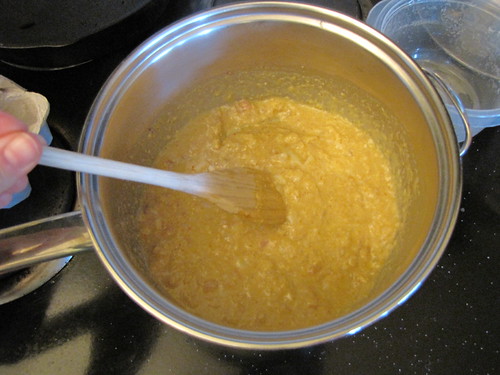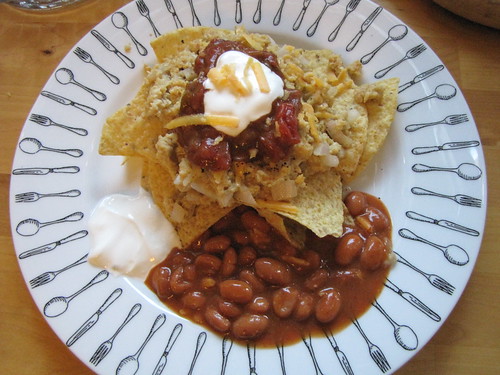 Such a terrible blogger I am. In May, I ended my last post with “We had some leftover chili sauce and onions, and used that to resurrect another recipe on the next day. Stay tuned for a post about that one.” And you are still waiting. I apologize.
Such a terrible blogger I am. In May, I ended my last post with “We had some leftover chili sauce and onions, and used that to resurrect another recipe on the next day. Stay tuned for a post about that one.” And you are still waiting. I apologize.
I didn’t waste all the time in the meantime, though. I spent part of it doing two more Master’s thesis drafts as well as a couple of research projects (one food-related, yes indeed). The thesis is now done (done! really!), so I hope I can get back to the business of recipe resurrecting.
I’ll start with a brief one I promised back in May. The last recipe I posted about was “Enchiladas, Mexican Style” from Gebhardt’s 1936 cookbook, Mexican Cookery for American Homes. This book, however, was not Gebhardt’s first cookbook for the American kitchen—that would be Mexican Cooking, published in about 1908. (Unfortunately, Google Books doesn’t have it freely available online even though it is in the public domain. It has been reprinted, though, and you can buy it here.)
This book is probably the first ever Mexican-American cookbook, and includes recipes such as “Tostadas de Queso—Cheese Toast (A Sunday-Night Supper)” and “Quesadilla Mexicana—Mexican Rarebit,” all featuring Gebhardt’s Eagle Chili Powder. It also has Enchiladas, but they are different from the flat stacked enchiladas in the 1937 cookbook. They are rolled, include homemade tortillas (called only “thin cakes” in this recipe, not tortillas), and it is suggested that “sardines cut into fine pieces are sometimes added.”
In the introduction, “To the American Housekeeper,” the book promises that:
“…We have spared neither labor nor expense in our efforts to give dishes that are pleasing, novel, and easily prepared.
While of the most simple nature, these recipes are those used by some of the most famous chefs of Old Mexico, and a careful reading of the following pages will enable you to surprise and please your friends and family with dishes that have graced the table of President Diaz and have made Mexican cooks as famous as those of France.”
Well, then. Let’s try some presidential cuisine. Page 31 features this recipe:
Huevos Con Queso—Eggs with Cheese
To six eggs use three tablespoonsful of grated mild cheese, one large tablespoonful of butter, one teaspoonful of onion juice or a small chopped onion; one half-teaspoonful of Gebhardt’s Eagle Chili Powder and salt to taste. Mix the cheese, butter, onion, chili powder and salt in a hot pan and stir until cheese is melted. Break the eggs into a bowl, adding the cheese and cook slowly, stirring until done, and then stir in chopped parsley and serve hot.
This is pretty straightforward despite being 102 years old. We had almost every ingredient available either from leftovers from the previous night’s enchilada experiment (such as the onions, cheese, chili powder, etc.) or because we had it on hand anyway (the eggs). The only ingredient we didn’t have was the chopped parsley, and I decided I could easily live without it.
Following the directions, I mixed the cheese, butter, leftover onion, Penzey’s chili powder, and salt in the pan. I beat the eggs and then stirred them into the cheese mixture. (I think the recipe may be missing a word when it says “Break the eggs into a bowl, adding the cheese and cook slowly.” Perhaps “adding to the cheese” is what was meant. But that part could certainly be phrased more clearly.)
The recipe just says “serve hot.” When looking at modern versions, though, I saw that the dish is often served on tortilla strips. I cheated and used tortilla chips I had on hand. I piled huevos on the chips, then put a dollop of chili sauce (made for the previous night’s enchiladas) and a smaller dollop of sour cream on the top, and a tiny sprinkle of grated cheese. I ate it with a side of beans and spicy sauce.
Verdict
It was good. It was not as spicy as I would have liked it, so if I make it again, I may experiment with more spice. Considering that the recipe is from 1908 and was written for an audience that may not have been as comfortable with hot and spicy foods as we are, I’m not surprised that it was a little mild. It was still tasty and I would certainly cook it again.
It was not, however, as good as the enchiladas from the previous night, which were tremendous.


